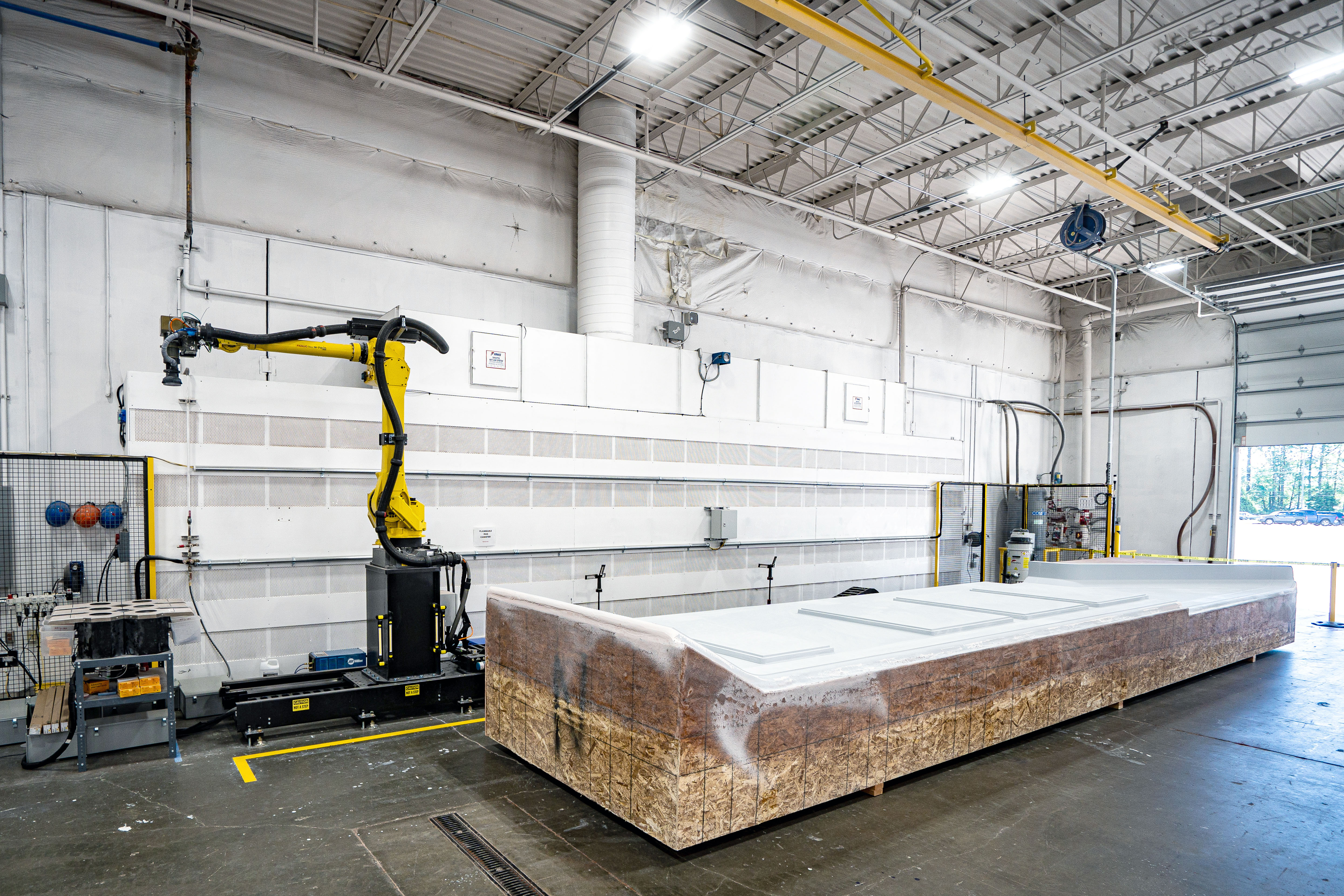Having technicians manual sand tooling on their hands and knees all day is hard on their bodies and is inconsistent because humans are not able to apply the same force on a workpiece throughout the day, said Hunter McKenzie, manufacturing engineer at Janicki Industries Inc., as he discussed the company’s sanding process. In addition to manufacturing aerospace, industrial and prototype parts, the company produces tooling made of putty and Invar, as well as steel, aluminum, composites, block foam and wood.
Janicki has facilities in Sedro-Woolley and Hamilton, Washington, and employs more than 1,700 people, with continued growth expected.
McKenzie added that the workpieces arrive from the mills with a scalloped surface. “We can have the parts come out of the mill perfectly smooth, but that adds a lot of mill time. Both Invar and putty parts alike would come into the finish bay and then we would hand sand them to remove the scallops.”
Seeking a solution, Janicki turned to GrayMatter Robotics in Carson, California, which offers the Scan&Sand robotic sanding system that incorporates artificial intelligence. The system provides consistent sanding performance for dimensional correction and surface finishing applications, resulting in defect-free surface finishes, according to GrayMatter.
END USER
Janicki Industries Inc.
888-856-5143
www.janicki.com
SOLUTION PROVIDER
GrayMatter Robotics
310-283-2335
www.graymatter-robotics.com
CHALLENGE
Eliminate physically demanding and inconsistent manual sanding of putty and Invar tooling.
SOLUTION
An artificial intelligence-power robotic sanding solution.

The workpieces measure from 1.83 m long by 1.22 m wide (6' by 4') up to 21.34 m long by 4.88 m wide (70' by 16'), which is the maximum pass of the mill, he noted.
The system’s M-710iC 6-axis Fanuc robot uses a laser scanner and an RGB camera to scan the surface of a part, McKenzie explained. “The laser scanner is used to determine the physical shape of the part, where the RGB camera is used for tape detection. Sometimes we are able to use the tape to avoid areas and also encapsulate the area you want to sand versus not sand.”
Because sanding putty generates a lot of fine dust, the system has a vacuum to suck up the dust and keep the work area clean, he said. Being a nickel-iron alloy, sanding Invar does not create as much dust, but the vacuum helps.
“The sanding cell is located in what we call our ‘putty land,’ which is where we make putty tooling,” McKenzie said, adding that the cell is technically located in the company’s B3 finishing bay, and the bay’s nickname also applies to the area where Janicki makes the putty.
With the GrayMatter system, putty sanding is an unmanned operation in which an operator presses a button to activate the robot and sand the workpiece, McKenzie noted. “Every once in a while, you have to fill up the sandpaper container.”
However, sanding Invar is semi-unmanned because the 36- to 80-grit sandpaper used for the workpiece material must be manually changed every 30 to 45 minutes, he said. Unlike the paper used to sand putty, which is 120- to 600-grit, the lower grit paper is not suitable for the automatic sandpaper changer. The changer can remove a used piece of sandpaper without a problem, but the roughness of low-grit paper, especially the 36-grit paper, causes the changer to pick up two or three sheets at a time instead of one.
“The robot doesn’t know how many pieces are on there. It just knows that there is at least one,” McKenzie said. “Having more than one piece on the robot can mess up your surface finish.”
He added that the surface finish for putty tooling is as fine as 35 Ra µin. and 45 to 50 Ra µin. for Invar tooling.
The system is set up for scanning Janicki’s four common part sizes of 1.23 m, 1.83 m, 2.44 m and 3.05 m (4', 6', 8' and 10'), McKenzie said. “The operator can say this part is 6-feet tall, I’m sanding putty, and I want to sand it to a 120 grit and clicks those three buttons. There are some popups that asks: is tape in place, is the part in the right location in the cell, is anyone in the cell. After that, he presses continue and the robot is off doing its own thing without any human involvement.”

The sanding cell measures 5.49 m long by 15.85 m wide (18' by 52'), he noted, and a laser sensor that surrounds the cell will automatically stop the robot if someone enters the cell. A radar system on two ends of the cell can be turned on to allow processing of parts larger than the cell. “Scan one section, sand it and move the part down 10 feet to sand it. The maximum part size we can put in there is 16 feet by 60 feet.”
The system is powered by GrayMatter’s GMR-AI application-specific software. With AI, once a part is scanned, the system plans the toolpaths for the robot to follow along the part as it sands while ensuring there are no collisions and the surface shapes are properly maintained, McKenzie said. “Without the AI system, all these parts we’d have to have someone manually plan out the toolpaths. With AI, you can have a tech who doesn’t have any experience with that run the cell.”
He added that GrayMatter continues to improve GMR-AI. “Specifically, for Janicki they do implement smaller individual updates for us because we are such a unique facility with the parts we run, but they also have overall updates that they send to everyone.”
For its putty patterns, McKenzie said Scan&Sand enabled Janicki to reduce the sanding time by 10% to 50%, with the higher reductions seen on large, flat parts. Invar parts still require an extensive amount of time to sand, but workers are able to perform other tasks while sanding takes place, and the company has seen a reduction in the estimated labor hours for sanding. “On Invar parts, the first tool we put in there was budgeted for 320 labor hours, and the robot was able to completely finish it in 90 hours. We were able to save about $100 per hour. We’re definitely seeing a good ROI.”
With the success Janicki Industries has experienced with the system, the company is working with GrayMatter to implement a grinding disc using the same robot and motor, McKenzie said. “That will open a lot of improvements in the Invar area for us.”
Depending on the process needed, he added that a different head can be put on the robot to perform sanding, grinding, blasting, coating, trimming, spraying, polishing/buffing and inspection.
Related Glossary Terms
- composites
composites
Materials composed of different elements, with one element normally embedded in another, held together by a compatible binder.
- flat ( screw flat)
flat ( screw flat)
Flat surface machined into the shank of a cutting tool for enhanced holding of the tool.
- grinding
grinding
Machining operation in which material is removed from the workpiece by a powered abrasive wheel, stone, belt, paste, sheet, compound, slurry, etc. Takes various forms: surface grinding (creates flat and/or squared surfaces); cylindrical grinding (for external cylindrical and tapered shapes, fillets, undercuts, etc.); centerless grinding; chamfering; thread and form grinding; tool and cutter grinding; offhand grinding; lapping and polishing (grinding with extremely fine grits to create ultrasmooth surfaces); honing; and disc grinding.
- land
land
Part of the tool body that remains after the flutes are cut.
- milling machine ( mill)
milling machine ( mill)
Runs endmills and arbor-mounted milling cutters. Features include a head with a spindle that drives the cutters; a column, knee and table that provide motion in the three Cartesian axes; and a base that supports the components and houses the cutting-fluid pump and reservoir. The work is mounted on the table and fed into the rotating cutter or endmill to accomplish the milling steps; vertical milling machines also feed endmills into the work by means of a spindle-mounted quill. Models range from small manual machines to big bed-type and duplex mills. All take one of three basic forms: vertical, horizontal or convertible horizontal/vertical. Vertical machines may be knee-type (the table is mounted on a knee that can be elevated) or bed-type (the table is securely supported and only moves horizontally). In general, horizontal machines are bigger and more powerful, while vertical machines are lighter but more versatile and easier to set up and operate.
- robotics
robotics
Discipline involving self-actuating and self-operating devices. Robots frequently imitate human capabilities, including the ability to manipulate physical objects while evaluating and reacting appropriately to various stimuli. See industrial robot; robot.

